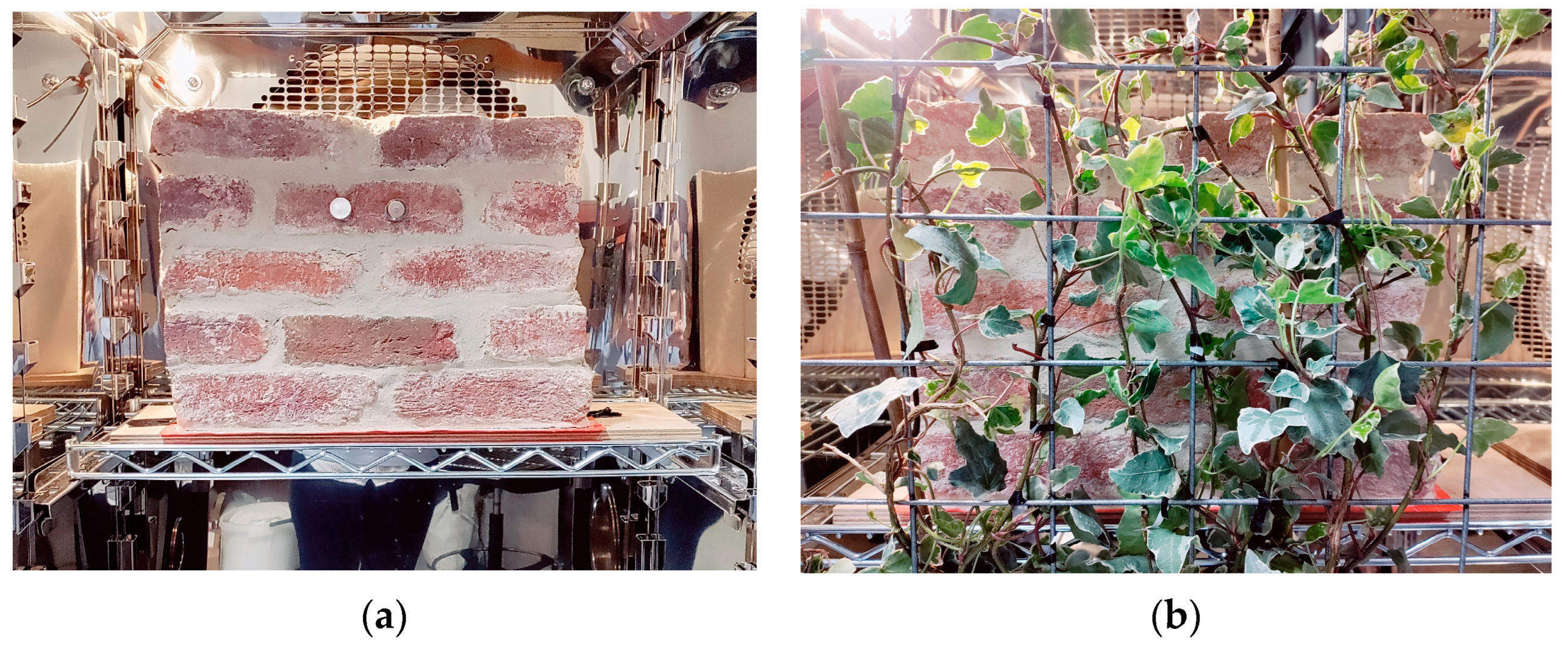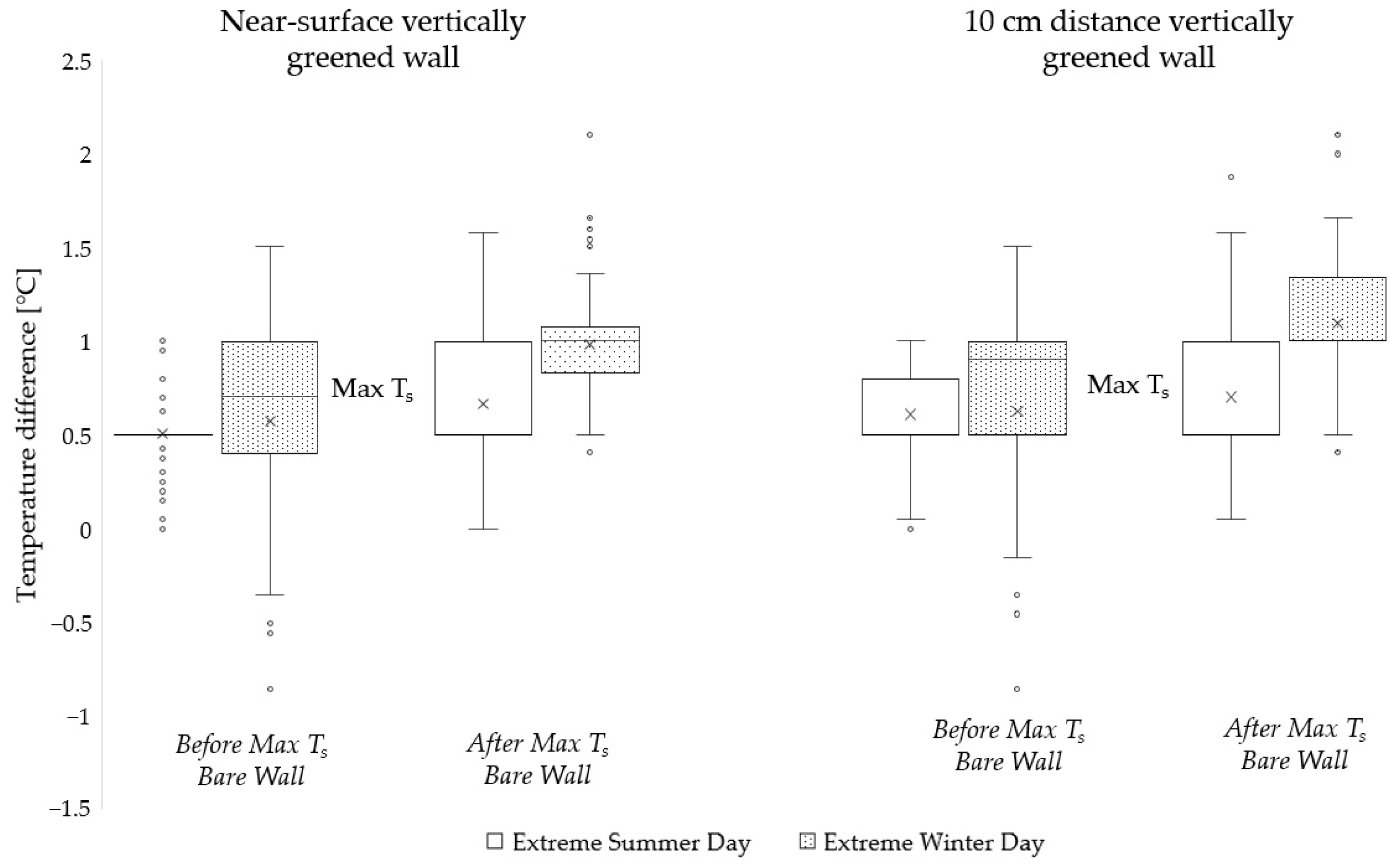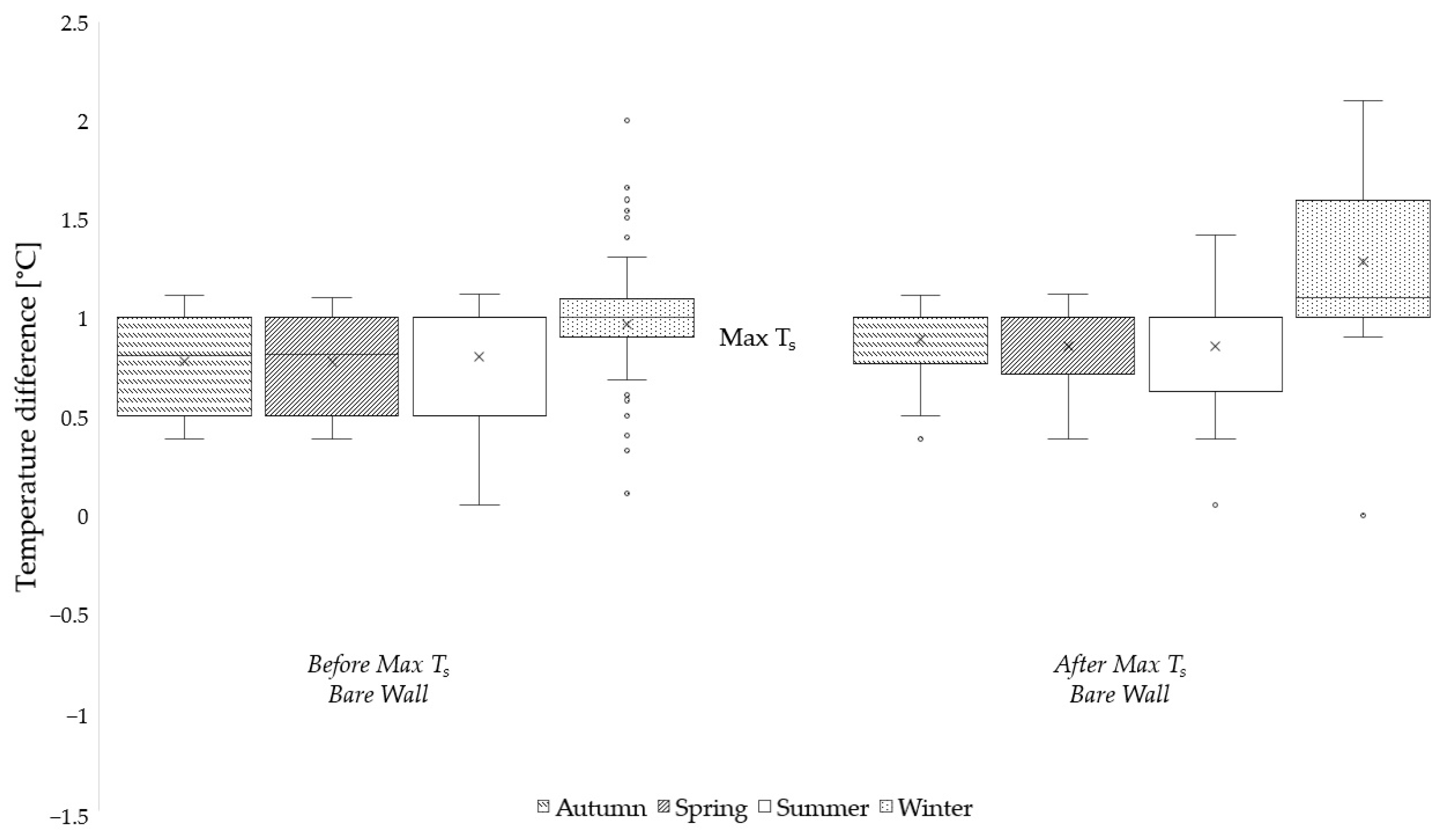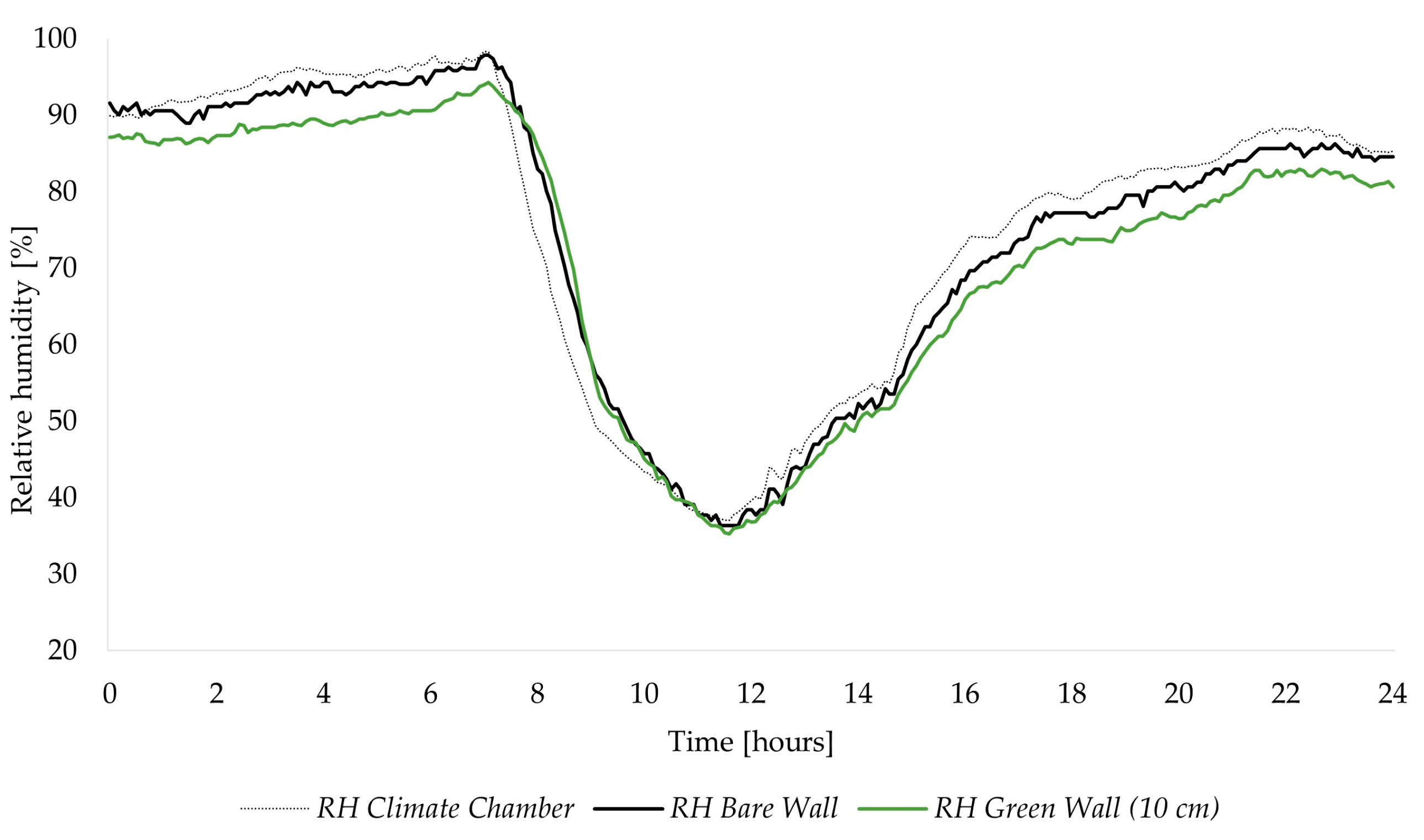Preliminary Experimental Laboratory Methods to Analyse the Insulation Capacity of Vertical Greening on Temperature and Relative Humidity
Abstract
:1. Introduction
2. Materials and Methods
2.1. Equipment
2.2. Methodology
3. Results
3.1. Temperature
3.2. Relative Humidity
4. Discussion
4.1. Advantages of Laboratory Environmental Simulations
4.2. Towards a Standardised Climate Chamber-Based Approach
4.3. Comparison to Case Study Approaches
4.4. Experimental Results and the Impact of Boundary Conditions
5. Conclusions
Author Contributions
Funding
Institutional Review Board Statement
Informed Consent Statement
Data Availability Statement
Acknowledgments
Conflicts of Interest
References
- Lafortezza, R.; Chen, J.; van den Bosch, C.K.; Randrup, T.B. Nature-based solutions for resilient landscapes and cities. Environ. Res. 2018, 165, 431–441. [Google Scholar] [CrossRef]
- Faivre, N.; Fritz, M.; Freitas, T.; de Boissezon, B.; Vandewoestijne, S. Nature-Based Solutions in the EU: Innovating with nature to address social, economic and environmental challenges. Environ. Res. 2017, 159, 509–518. [Google Scholar] [CrossRef] [PubMed]
- Xing, Y.; Jones, P.; Donnison, I. Characterisation of Nature-Based Solutions for the Built Environment. Sustainability 2017, 9, 149. [Google Scholar] [CrossRef] [Green Version]
- Dover, J.W. Green Infrastructure: Incorporating Plants and Enhancing Biodiversity in Buildings and Urban Environments; Routledge: London, UK, 2015. [Google Scholar]
- Norton, B.A.; Coutts, A.M.; Livesley, S.J.; Harris, R.J.; Hunter, A.M.; Williams, N.S.G. Planning for cooler cities: A framework to prioritise green infrastructure to mitigate high temperatures in urban landscapes. Landsc. Urban Plan. 2015, 134, 127–138. [Google Scholar] [CrossRef]
- Ottelé, M. The green building envelope: Vertical greening. Ph.D. Thesis, TU Delft, Delft, The Netherlands, 2011. [Google Scholar]
- Wang, P.; Wong, Y.H.; Tan, C.Y.; Li, S.; Chong, W.T. Vertical Greening Systems: Technological Benefits, Progresses and Prospects. Sustainability 2022, 14, 12997. [Google Scholar] [CrossRef]
- Koch, K.; Ysebaert, T.; Denys, S.; Samson, R. Urban heat stress mitigation potential of green walls: A review. Urban For. Urban Green. 2020, 55, 126843. [Google Scholar] [CrossRef]
- National Weather Service. Discussion on Humidity. Available online: https://www.weather.gov/lmk/humidity (accessed on 5 December 2022).
- De Bock, A.; Belmans, B.; Vanlanduit, S.; Blom, J.; Alvarado-Alvarado, A.; Audenaert, A. A review on the leaf area index (LAI) in vertical greening systems. Build. Environ. 2023, 229, 109926. [Google Scholar] [CrossRef]
- Kenai, M.-A.; Libessart, L.; Lassue, S.; Defer, D. Impact of green walls occultation on energy balance: Development of a TRNSYS model on a brick masonry house. J. Build. Eng. 2021, 44, 102634. [Google Scholar] [CrossRef]
- Sternberg, T.; Viles, H.; Cathersides, A.; Edwards, M. Dust particulate absorption by ivy (Hedera helix L) on historic walls in urban environments. Sci. Total. Environ. 2010, 409, 162–168. [Google Scholar] [CrossRef]
- Koyama, T.; Yoshinaga, M.; Hayashi, H.; Maeda, K.-I.; Yamauchi, A. Identification of key plant traits contributing to the cooling effects of green façades using freestanding walls. Build. Environ. 2013, 66, 96–103. [Google Scholar] [CrossRef]
- Msl. IButton DS1923 Hygrochron Temperature/Humidity Data Logger. Available online: https://www.measurementsystems.co.uk/data-logging/miniature_temperature_loggers/ds1923_hygrochron_temperature_humidity_data_logger (accessed on 11 June 2023).
- Caluwaerts, S.; Top, S.; Vergauwen, T.; Wauters, G.; De Ridder, K.; Hamdi, R.; Mesuere, B.; Van Schaeybroeck, B.; Wouters, H.; Termonia, P. Engaging Schools to Explore Meteorological Observational Gaps. Bull. Am. Meteorol. Soc. 2021, 102, E1126–E1132. [Google Scholar] [CrossRef]
- Ramon, D.; Allacker, K.; De Troyer, F.; Wouters, H.; van Lipzig, N.P. Future heating and cooling degree days for Belgium under a high-end climate change scenario. Energy Build. 2020, 216, 109935. [Google Scholar] [CrossRef]
- Ottelé, M.; Perini, K. Comparative experimental approach to investigate the thermal behaviour of vertical greened façades of buildings. Ecol. Eng. 2017, 108, 152–161. [Google Scholar] [CrossRef] [Green Version]
- Vox, G.; Blanco, I.; Fuina, S.; Campiotti, C.A.; Mugnozza, G.S.; Schettini, E. Evaluation of wall surface temperatures in green facades. Proc. Inst. Civ. Eng. Eng. Sustain. 2017, 170, 334–344. [Google Scholar] [CrossRef]
- Vox, G.; Blanco, I.; Schettini, E. Green façades to control wall surface temperature in buildings. Build. Environ. 2018, 129, 154–166. [Google Scholar] [CrossRef]
- Daemei, A.B.; Shafiee, E.; Chitgar, A.A.; Asadi, S. Investigating the thermal performance of green wall: Experimental analysis, deep learning model, and simulation studies in a humid climate. Build. Environ. 2021, 205, 108201. [Google Scholar] [CrossRef]
- Blanco, I.; Schettini, E.; Vox, G. Effects of vertical green technology on building surface temperature. Int. J. Des. Nat. Ecodynamics Urban Agric. City Sustain. 2018, 13, 384–394. Available online: https://www.witpress.com/elibrary/dne-volumes/13/4/2349 (accessed on 3 July 2023). [CrossRef] [Green Version]
- Blanco, I.; Schettini, E.; Vox, G. Predictive model of surface temperature difference between green façades and uncovered wall in Mediterranean climatic area. Appl. Therm. Eng. 2019, 163, 114406. [Google Scholar] [CrossRef]
- Pérez, G.; Coma, J.; Chàfer, M.; Cabeza, L.F. Seasonal influence of leaf area index (LAI) on the energy performance of a green facade. Build. Environ. 2021, 207, 108497. [Google Scholar] [CrossRef]
- Cameron, R.W.; Taylor, J.E.; Emmett, M.R. What’s ‘cool’ in the world of green façades? How plant choice influences the cooling properties of green walls. Build. Environ. 2014, 73, 198–207. [Google Scholar] [CrossRef] [Green Version]
- Akbari, H.; Cartalis, C.; Kolokotsa, D.; Muscio, A.; Pisello, A.L.; Rossi, F.; Santamouris, M.; Synnefa, A.; Wong, N.H.; Zinzi, M. Local Climate Change and Urban Heat Island Mitigation Techniques—The State of the Art. J. Civ. Eng. Manag. 2015, 22, 1–16. [Google Scholar] [CrossRef] [Green Version]
- Zhao, L.; Lee, X.; Smith, R.B.; Oleson, K. Strong contributions of local background climate to urban heat islands. Nature 2014, 511, 216–219. [Google Scholar] [CrossRef] [PubMed]
- Akbari, H.; Pomerantz, M.; Taha, H. Cool surfaces and shade trees to reduce energy use and improve air quality in urban areas. Sol. Energy 2001, 70, 295–310. [Google Scholar] [CrossRef]
- Hall, K. Rock moisture content in the field and the laboratory and its relationship to mechanical weathering studies. Earth Surf. Process. Landf. 1986, 11, 131–142. [Google Scholar] [CrossRef]
- Deprez, M.; De Kock, T.; De Schutter, G.; Cnudde, V. A review on freeze-thaw action and weathering of rocks. Earth-Sci. Rev. 2020, 203, 103143. [Google Scholar] [CrossRef]
- Siegesmund, S.; Snethlage, R. Stone in Architecture; Springer: Berlin/Heidelberg, Germany, 2014. [Google Scholar] [CrossRef]
- Camuffo, D. Microclimate for Cultural Heritage: Conservation, Restoration, and Maintenance of Indoor and Outdoor Monuments, 2nd ed.; Elsevier: Amsterdam, The Netherlands, 2014. [Google Scholar]
- Fiscbetti, D.C.; Baer, N.S.; Fitz, S.; Livingston, R.A. Conservation of Historic Brick Structures—Case Studies and Reports of Research. APT Bull. 2001, 32, 73. [Google Scholar] [CrossRef]
- Godts, S.; Orr, S.A.; Desarnaud, J.; Steiger, M.; Wilhelm, K.; De Clercq, H.; Cnudde, V.; De Kock, T. NaCl-related weathering of stone: The importance of kinetics and salt mixtures in environmental risk assessment. Herit. Sci. 2021, 9, 44. [Google Scholar] [CrossRef]






| Season (Intensity) | Autumn (50) | Spring (50) | Summer (50) | Winter (50) | Summer (95) | Winter (95) | |
|---|---|---|---|---|---|---|---|
| Characteristics of cooling phase of the bare wall | |||||||
| Temperature difference (°C) | 3.62 | 9.02 | 8.00 | 3.51 | 11.50 | 6.53 | |
| Duration (h) | 9.40 | 9.42 | 9.00 | 9.30 | 12.75 | 8.25 | |
| Cooling rate (°C/h) | 0.38 | 0.96 | 0.89 | 0.38 | 0.90 | 0.79 | |
| Impact of vertical greening on the temperature differences of the cooling phase | |||||||
| Average temperature difference (°C) | Near | 0.57 | 0.61 | 0.65 | 1.23 | 0.67 | 0.98 |
| 10 cm | 0.89 | 0.86 | 0.86 | 1.28 | 0.70 | 1.10 | |
| Maximum temperature difference (°C) | Near | 1.11 | 1.11 | 1.19 | 2.10 | 1.58 | 2.10 |
| 10 cm | 1.11 | 1.12 | 1.42 | 2.10 | 1.88 | 2.10 | |
| Significancy test cooling phase | |||||||
| p-value, Kruskal–Wallis test | Near | 0.02544 | 0.03226 | 0.15105 | <0.00001 | 0.43581 | 0.23041 |
| 10 cm | 0.00008 | 0.00704 | 0.02805 | <0.00001 | 0.38407 | 0.04338 | |
Disclaimer/Publisher’s Note: The statements, opinions and data contained in all publications are solely those of the individual author(s) and contributor(s) and not of MDPI and/or the editor(s). MDPI and/or the editor(s) disclaim responsibility for any injury to people or property resulting from any ideas, methods, instructions or products referred to in the content. |
© 2023 by the authors. Licensee MDPI, Basel, Switzerland. This article is an open access article distributed under the terms and conditions of the Creative Commons Attribution (CC BY) license (https://creativecommons.org/licenses/by/4.0/).
Share and Cite
De Groeve, M.; Kale, E.; Orr, S.A.; De Kock, T. Preliminary Experimental Laboratory Methods to Analyse the Insulation Capacity of Vertical Greening on Temperature and Relative Humidity. Sustainability 2023, 15, 11758. https://doi.org/10.3390/su151511758
De Groeve M, Kale E, Orr SA, De Kock T. Preliminary Experimental Laboratory Methods to Analyse the Insulation Capacity of Vertical Greening on Temperature and Relative Humidity. Sustainability. 2023; 15(15):11758. https://doi.org/10.3390/su151511758
Chicago/Turabian StyleDe Groeve, Marie, Eda Kale, Scott Allan Orr, and Tim De Kock. 2023. "Preliminary Experimental Laboratory Methods to Analyse the Insulation Capacity of Vertical Greening on Temperature and Relative Humidity" Sustainability 15, no. 15: 11758. https://doi.org/10.3390/su151511758
APA StyleDe Groeve, M., Kale, E., Orr, S. A., & De Kock, T. (2023). Preliminary Experimental Laboratory Methods to Analyse the Insulation Capacity of Vertical Greening on Temperature and Relative Humidity. Sustainability, 15(15), 11758. https://doi.org/10.3390/su151511758






